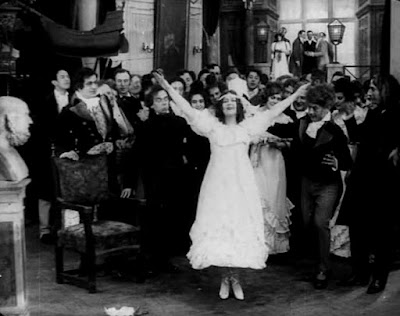Director: Richard Oswald
Based loosely on the opera by Jaques Offenbach, we present the amorous adventures of ETA Hoffman's eponymous hero, possibly the unluckiest lover in the history of mankind... Persecuted at every turn by nefarious nemeses in his romances with a living marionette, a deceitful actress and a girl who dances herself to death...
1790: The young Hoffman lives in the care of his aunt and uncle. They receive a visit from the Conte Dapertutto, who Hoffman dislikes intensely. When the insubordinate young Hoffman is later banished to his room, he sneaks out through the window. Soon he encounters the alchemist Coppelius and his associate Spalanzani, who attempt to steal his eyes for their own experiments: Hoffman gets away.
He is soon taken in by the dancer Angela, and her husband Rath Crespel. The Crespels call in Dr Mirakel to aid Hoffman, but Mirakel is more interested in Angela. Hoffman protects Angela from Mirakel's advances, but Mirakel later returns and hypnotically forces Angela to dance for him. Angela's mysterious illness means that the exertion is too much, and she dies on the spot.
Berlin, 1808: after being spurned by an actress named Stella, Hoffman moves to another town, where he again comes across Coppelius and Spalanzani. Hoffman is invited to a celebration to meet Spalanzani's 'daughter' Olympia, in reality a life-size automaton. Coppelius dupes Hoffman into wearing a pair of magic eyeglasses that make inanimate objects come to life. Hoffman falls in love with Olympia, but when the deception is revealed, tears the automaton to pieces.
 |
| Dance of Death: Dr Mirakel (AV Horn) disposes of Antonia Crespel |
Later, Hoffman is reunited with Antonia, the daughter of Angela and Rath Crespel, though Dr Mirakel is still around and asks Crespel for Antonia's hand in marriage. Crespel refuses. Mirakel jealously tricks Hoffman into making Antonia dance, knowing she shares the affliction that killed her mother. When she collapses from exhaustion, Mirakel is again on hand to pronounce her dead.
Notes:
It's hard to know what to make of this early version of Hoffman's tales after the best part of a century. The storyline differs from both the opera on which it is ostensibly based and the original tales written by ETA Hoffman in the early 1800's. Those three tales, The Sandman, The Cremona Violin and The Lost Reflection, are simplified here; characters and incidents are sometimes omitted, sometimes merged. Coupled with the possibility of lost footage, this often makes the film difficult to follow for anyone not familiar with the source material.
Interestingly, the tales' fantasy elements are downplayed, a surprising approach for a director who seemed rarely to shy away from outlandish material. The Lost Reflection in particular has been shorn completely of its supernatural elements (Dapertutto's scheme to steal Hoffman's reflection) to become a fairly mundane story of love and betrayal. Likewise, the wicked Dr Mirakel's Svengali-like influence over the Crespel women is never fully explored. It's only in the episode featuring Hoffman's delusional love for the mechanical Olympia that we get a real taste of the author's (capital-R) Romanticism, as presented so expertly in Powell and Pressburger's 1951 version.
Exteriors for the present film were, according to the prologue, shot in Jena in eastern Germany. The rather grim and desolate-looking streets and courtyards on screen underline the film's prosaic tone, but ultimately work in its favour. That sense of decay, of a harsh and vaguely hostile environment, adds a texture that studio sets wouldn't have captured. This was the same approach taken by Stellan Rye with The Student of Prague in 1913; though in the end it seems as though director Oswald is aiming for one of those odd hybrids of biography and fiction that we'd see in films like Charles Brabin's The Raven.
Appropriately, the cast of Hoffman features an ensemble gathered from Berlin's finest theatres, including the spectacularly-named Erich Kaiser-Titz in the lead role, and a gruff Werner Krauss, three years before he donned the top hat, cape and gloves of Dr Caligari. Hoffman's persecutors - a reptilian AV Horn as Dr Mirakel and Freidrich Kuhne as Severus-Snape-alike Coppelius - get the meatiest parts: the female leads, as one might expect of a time before the Star System got a foothold, are pretty but interchangeable. In the end it's the director's film, although missing footage and a frustrating lack of information make it hard to see from this distance exactly what Oswald was hoping to achieve.
End Credits:
Erich Kaiser-Titz (ETA Hoffman), Kurt Wolowsky (Young Hoffman), Werner Krauss (Conte Dapertutto), Max Ruhbeck (The Uncle), Paula Ronay (The Aunt), Friedrich Kuenhe (Coppelius), Lupu Pick (Spalanzani), Ernst Ludwig (Rath Crespel), Relly Ridon (Angela Crespel), AV Horn (Dr Mirakel), Ruth Oswald (Little Antonia), Ferdinand Bonn (Lindorf), Kaete Oswald (Stella), Alice Scheel-Heschy (Olympia), Thea Sandten (Giulietta).
Scenario: Richard Oswald and Fritz Freidmann-Frederich, based on stories by ETA Hoffman and the opera by Jaques Offenbach, Cinematography: Ernst Krohn, Art Director: Manfred Noa, Art objects and interior design: Freidmann and Weber.
Lothar, Germany
Running Time 71mins.
Availability:
Not available commercially, though prints may be found . . . if one has magic eyeglasses.



No comments:
Post a Comment